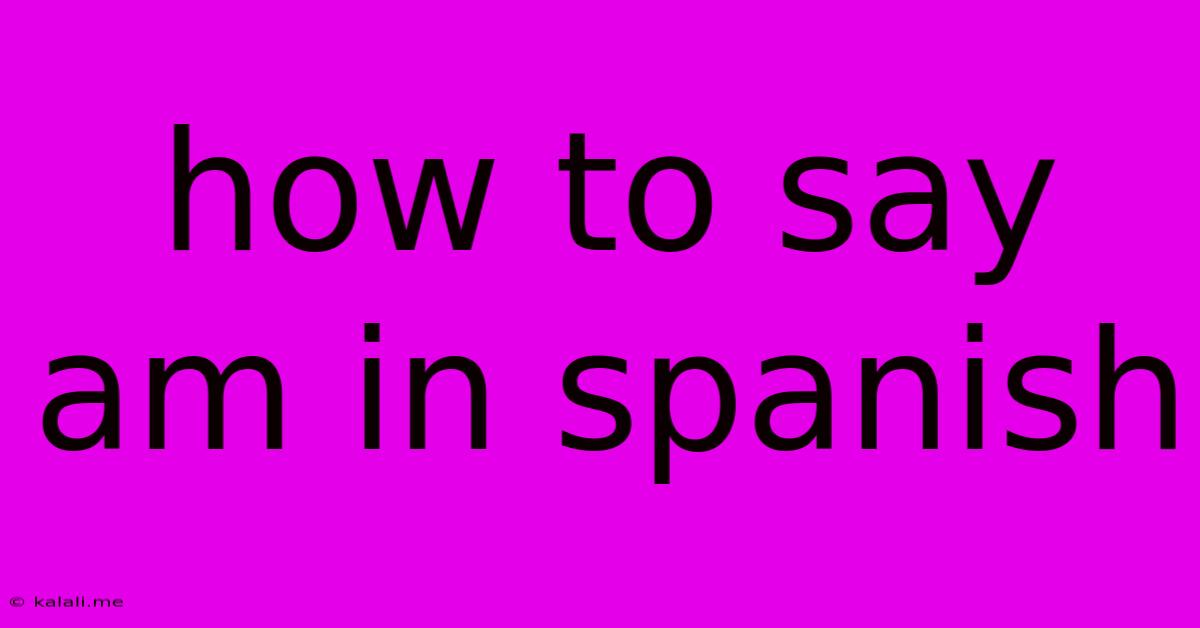How To Say Am In Spanish
Kalali
Jun 04, 2025 · 3 min read

Table of Contents
How to Say "I Am" in Spanish: A Comprehensive Guide
This article will delve into the nuances of expressing "I am" in Spanish, exploring different contexts and providing you with the tools to confidently use this fundamental phrase. Understanding the various conjugations of the verb ser and estar is key to mastering this seemingly simple concept. This guide will cover both formal and informal situations, ensuring you can communicate effectively in diverse Spanish-speaking environments.
The most straightforward translation of "I am" in Spanish depends heavily on what you are. While English uses a single verb, Spanish employs two: ser and estar. Both mean "to be," but they express different aspects of being. Choosing the correct verb is crucial for accurate and natural-sounding Spanish.
Ser vs. Estar: The Core Distinction
-
Ser (to be): This verb describes inherent or permanent qualities, origins, relationships, and essential characteristics. Think of it as describing what something is fundamentally.
-
Estar (to be): This verb describes temporary states, locations, conditions, and emotions. Think of it as describing what something is like at a particular moment.
How to Say "I Am" Using Ser
We use ser to express:
- Identity: "I am John" - Soy Juan.
- Origin: "I am from Spain" - Soy de España.
- Profession: "I am a doctor" - Soy médico.
- Characteristics: "I am tall" - Soy alto (for a male), Soy alta (for a female). Note the gender agreement!
- Possession (using ser + de): "This book is mine" - Este libro es mío.
Conjugation of Ser:
| Pronoun | Conjugation |
|---|---|
| Yo (I) | Soy |
| Tú (You - informal) | Eres |
| Él/Ella/Usted (He/She/You - formal) | Es |
| Nosotros/as (We) | Somos |
| Vosotros/as (You - informal, Spain) | Sois |
| Ellos/Ellas/Ustedes (They/You - formal) | Son |
How to Say "I Am" Using Estar
We use estar to express:
- Location: "I am in the park" - Estoy en el parque.
- Temporary State: "I am tired" - Estoy cansado (for a male), Estoy cansada (for a female).
- Emotions: "I am happy" - Estoy contento (for a male), Estoy contenta (for a female).
- Conditions: "I am sick" - Estoy enfermo (for a male), Estoy enferma (for a female).
- Continuous Actions (with gerunds): "I am working" - Estoy trabajando.
Conjugation of Estar:
| Pronoun | Conjugation |
|---|---|
| Yo (I) | Estoy |
| Tú (You - informal) | Estás |
| Él/Ella/Usted (He/She/You - formal) | Está |
| Nosotros/as (We) | Estamos |
| Vosotros/as (You - informal, Spain) | Estáis |
| Ellos/Ellas/Ustedes (They/You - formal) | Están |
Putting it All Together: Practice Makes Perfect
The best way to master the difference between ser and estar is through practice. Try constructing sentences using both verbs with different adjectives and descriptions. Pay close attention to the context and the type of "being" you are trying to convey. Immersing yourself in the Spanish language through movies, music, and conversations will greatly enhance your understanding. Don't be afraid to make mistakes; they are a natural part of the learning process. With consistent effort, you'll become fluent in expressing yourself using "I am" in Spanish!
Latest Posts
Latest Posts
-
Can A Alternator Go Bad From Sitting
Jun 06, 2025
-
How To Tells Omeone You Want To Just Be Friends
Jun 06, 2025
-
Substitute White Flour For Whole Wheat Flour
Jun 06, 2025
-
Why Is The Word Stuff Funny To Use
Jun 06, 2025
-
What To Call Fellow Classmastes In Ma Program
Jun 06, 2025
Related Post
Thank you for visiting our website which covers about How To Say Am In Spanish . We hope the information provided has been useful to you. Feel free to contact us if you have any questions or need further assistance. See you next time and don't miss to bookmark.